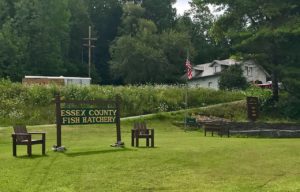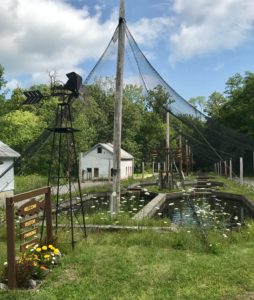Andebit et beaqui corendit, ut quostes esciendion re dit ad et prae parion es quia quas alibus sam, omnim faciden ducipidiat arum autem nobis enis es voat

4. The Fish Hatchery via Creek Road
The Power of Water
Listen to the Site 4 Audio Narration of the Iron Story

Much of the local story of iron requires some imagination to visualize the bustling communities that once dotted the landscape. This stretch of road is no different. As you drive up Creek Road, following Putnam Creek, this beautiful landscape is heavily forested and lush. But during the days of iron mining, the landscape would have been unrecognizable. Almost all of the trees would have been gone—used for lumber or turned into charcoal to power the iron forges and furnaces. And the creek would have been dotted with some 100 waterwheels. (Granted many businesses had multiple waterwheels, and some were small, personal waterwheels.) Water literally powered the industry here. Where iron went, other industries followed. By the mid-1800s, the iron industry was established as the chief commercial enterprise in the Adirondack-Champlain region. The impact on communities was huge. Sometimes operating in tandem with iron forges and mines were horseshoe nail factories and iron rolling mills. (Similar to rolling dough, wrought iron was sometimes passed through one or more pairs of rolls to reduce the thickness and to make it uniform.) Agriculture and transportation were also stimulated by the iron industry. The large population supported by mining and iron making created a substantial market for food products. Draft animals used in the iron industry created sizable demand for hay and oats. All that demand for supplies required wagons, carts, and boats to move products where they were needed.

The spread of the iron industry also bolstered the growth of towns. By 1860, the iron industry played a major role in the founding and growth of more than 60 villages and hamlets in the Adirondacks. Factoryville is an example of a prosperous town that then disappeared when the iron mining industry came to an end. The aptly named small town, which is now barely recognizable as a small cluster of buildings, once had a school, sash and door factory, a brush factory, and Crown Point’s first iron forge (now the site of the fish hatchery). Just west of the intersection with White Church Road is Crown Point Center—a name that no longer reflects the sparse assortment of buildings left standing. Once a lively town, it was home to a grist mill, tannery, woolen mill, school, stores, and a hotel. The first settlers of Crown Point lived in Buck Hollow; now all that’s left of it is a small sign on your left for “Buck Hollow Cemetery.”In 1885, H. Perry Smith, in his book History of Essex County, wrote this description of Bucks Hollow:“As early as 1807 Elisha Rhoades built a tavern and dancing hall. It still stands at “Buck Hollow” and is known as “The Old Rookery.” He finished the structure in time to dedicate it with a New Year’s ball. A large party assembled, coming with ox teams or on foot, and the affair was a pronounced success. It was not exactly a modern dancing party in high society, but it sufficed just as well and was, doubtless, just as much enjoyed by the participants as are the more elaborate social events of modern days.”There are no more grand balls here, but there is plenty of fish farming. The present-day fish hatchery was the site of John Renne’s forge, the first in Crown Point, which opened in 1823. Just five years earlier, Samuel Renne, who ran a ferry across Lake Champlain, discovered a promising vein of iron that became known as “ The pioneers of iron were all connected: Samuel Renne was a brother of John Renne, who in turn was father-in-law to Charles Hammond. The ore worked by John Renne came principally from the Cheever bed, in Moriah, with a little from the bed opened by Samuel Renne, until the discovery of the Penfield bed.
Travel Tools
As you follow Creek Road (Essex County Route 2) west up into Ironville, imagine this entire area without any trees. Trees—in the form of charcoal—were the fuel used to fire the forges and later blast furnaces. See if you can identify the cluster of buildings known as Factoryville (Pond’s Sash and Door factory; Brush Factory) grouped just before and after the Factoryville Road intersection. The present-day fish hatchery on your left was the site of John Renne’s iron forge. At the north-west corner of the Factoryville intersection, you’ll see what’s probably the most unique vestige of the town, an octagonal building, once home to a prominent businessman of the town, C.T. Forbes.
At the bridge here is a site of remembrance for the sailors killed in the Civil War. Further west, just past the intersection with White Church Road, is Crown Point Center. A little further west is Buck Hollow—all that’s left to see of this once-lively town is the sign for Buck Hollow Cemetery.
The Fish Hatchery is worth a visit in its own right too. The Essex County Fish Hatchery now releases some 55,000 young trout annually into roughly 65 bodies of water, making it one of the most unique and ambitious stocking programs in the northeastern United States. This is a great place for people who love checking out fish and learning about how they are raised. Over a dozen rearing ponds, full of rainbow, brown, and brook trout, are located on-site for the public to view. The fish are released in every town in Essex County.


